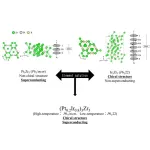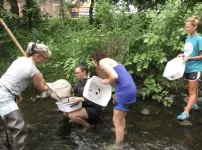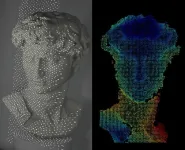(Press-News.org) For years, there has been a long-held belief that acute viral infections like Zika or COVID-19 are directly responsible for neurological damage, but researchers from McMaster University have now discovered that it’s the immune system’s response that is behind it.
The research, published on Feb. 5, 2024 in Nature Communications, was led by Elizabeth Balint, a PhD student at McMaster, and Ali Ashkar, a professor with the Department of Medicine and the Canada Research Chair in Natural Immunity and NK Cell Function.
“We were interested in trying to understand why so many viral infections are associated with neurological diseases,” says Balint. “Our evidence suggests that it's not the virus itself that causes the damage, but a unique population of T cells, which are part of the immune system, that are actually responsible for the damage."
To come to this conclusion, the McMaster team focused on Zika virus. During laboratory testing, researchers, as expected, found T cells that were specific for Zika and designed to eliminate infected cells. They found something else, too.
“What was interesting in our study is that although we did find some T cells specific for Zika, we identified cells that weren’t functioning like a normal T cell and were killing lots of cells that weren’t infected with Zika."
These cells are called NKG2D+CD8+ T cells and researchers say their aggressive response is responsible for neurological damage suffered from infections beyond just Zika, like COVID-19 and even septic shock.
The aggressive response is the result of the body producing large amounts of inflammatory proteins called cytokines, which in moderation help to coordinate the body’s response in battling an infection or injury by telling immune cells where to go and what to do when they arrive.
"If our body’s immune cells overreact and over produce inflammatory cytokines, this condition will lead to non-specific activation of our immune cells which in turn leads to collateral damage. This can have severe consequences if it happens in the brain,” Ashkar says.
The discovery offers researchers and scientists a new target for treatments of neurological diseases sparked by acute viral infections. In fact, Balint has already found a treatment that holds promise.
“Elizabeth has experimented with an antibody that can completely block and treat devastating neurotoxicity in the animal model, which is already in clinical trials for different uses in humans," says Ashkar.
Balint hopes to continue her work towards finding a treatment that would be effective in humans.
"There are a few different other viruses we’re interested in studying, which will aid us in creating the best treatment options," Balint says.
Funding for this study was provided by the Canadian Institutes of Health Research. Balint is also a recipient of a Canada Graduate Scholarship Doctoral Award.
END
Immune response, not acute viral infections, responsible for neurological damage, McMaster researchers discover
2024-02-05
ELSE PRESS RELEASES FROM THIS DATE:
Scientists mix and match properties to make new superconductor with chiral structure
2024-02-03
Tokyo, Japan – Researchers from Tokyo Metropolitan University have created a new superconductor with a chiral crystalline structure by mixing two materials, one with superconductivity but no chirality, another with chirality but no superconductivity. The new platinum-iridium-zirconium compound transitions to a bulk superconductor below 2.2 K and was observed to have chiral crystalline structure using X-ray diffraction. Their new solid solution approach promises to accelerate the discovery and understanding of ...
Cary Institute receives NSF funding to offer ecological research experiences for teachers
2024-02-03
(Millbrook, NY) Cary Institute for Ecosystem Studies is launching a new program to support high school and middle school educators in teaching global change and ecology. Starting in the summer of 2024, nine teachers will spend six weeks at Cary Institute conducting collaborative research in ecosystem science. Follow-up meetings throughout the school year will support the teachers as they develop and implement innovative curricula based on their research experiences.
The program is funded by a three-year award from the National Science Foundation as part of its Research ...
California voter poll: Schiff leads, while Porter and Garvey neck-and-neck for second in the U.S. Senate primary
2024-02-03
U.S. Rep. Katie Porter and former Los Angeles Dodger Steve Garvey are deadlocked in the race for second place in the U.S. Senate primary in California, according to a new poll on California politics and policies from USC; California State University, Long Beach; and Cal Poly Pomona.
U.S. Rep. Adam Schiff, a Democrat, leads all candidates with 25% of likely voters, according to the California Elections and Policy Poll. Porter, a Democrat, and Garvey, a Republican, each received support from 15%. Other candidates are in single digits, with Democratic U.S. Rep. ...
Researchers identify protein linked to metastasis in pancreatic cancer
2024-02-03
Pancreatic cancer is the No. 3 cause of cancer-related deaths in the United States, and only 12% of patients survive five years after being diagnosed. Severe pancreatic cancer is associated with metastasis, and it is this spread of secondary tumors that usually causes death, but little is known about the molecular mechanisms that drive metastasis.
In a study published Dec. 18 in Advanced Science, researchers from the University of California, Davis showed that abnormal expression of the protein Engrailed-1 (EN1) ...
Common food preservative has unexpected effects on the gut microbiome
2024-02-02
Food manufacturers often add preservatives to food products to keep them fresh. A primary purpose of these preservatives is to kill microbes that could break down and otherwise spoil the food. Common additives like sugar, salt, vinegar and alcohol have been used as preservatives for centuries, but modern-day food labels now reveal more unfamiliar ingredients such as sodium benzoate, calcium propionate, and potassium sorbate.
Bacteria produce chemicals called bacteriocins to kill microbial competitors. These chemicals can serve as natural preservatives by killing potentially dangerous pathogens ...
Single-port robotic surgery is making its debut in the mountain west
2024-02-02
Huntsman Cancer Institute at the University of Utah (the U) proudly introduces the first and only single-port robot in the Mountain West for head and neck surgical oncology patients. This state-of-the-art technology is a groundbreaking step in the field of oncological surgery, allowing for greater precision and less invasive procedures. Under the visionary leadership of dedicated healthcare professionals, the institute is committed to revolutionizing treatments for cancer patients.
“I am delighted that Huntsman Cancer Institute can now offer cancer patients in the Mountain West access to this innovative and life-changing technology,” says Sachin ...
Potential to ‘save more lives than doctors’: Rice launches WaTER Institute to develop accessible clean water technology
2024-02-02
Forty-three million Americans lack access to municipal water, and 1 in 10 people globally do not have access to safe drinking water. Rice University’s new WaTER Institute, launched today, aims to address this and other complex water-related challenges.
“Clean water can save more lives than doctors,” said Pedro J. Alvarez , the institute’s director and the George R. Brown Professor of Civil and Environmental Engineering.
The institute’s researchers will also predict and prevent diseases by monitoring wastewater; ...
New guidelines aim to elevate comprehensive care for people with severe epilepsy
2024-02-02
(February 2, 2024) The National Association of Epilepsy Centers (NAEC) has developed updated guidelines that outline the comprehensive services and resources epilepsy centers should provide to improve quality of care for people whose epilepsy is not well-controlled.
An Executive Summary of the 2023 Guidelines for Specialized Epilepsy Centers: Report of the National Association of Epilepsy Centers Guideline Panel was published online on February 2, 2024, in Neurology®, the medical journal of the American Academy of Neurology. The complete NAEC guidelines are published as an eAppendix on the journal’s website.
Epilepsy is one of the most ...
Welch Foundation supports Johnson-Winters' TB research
2024-02-02
With a $300,000 grant, the Welch Foundation is supporting University of Texas at Arlington research into why some types of Mycobacterium tuberculosis (Mtb), the bacteria that causes the lung disease tuberculosis (TB), do not respond to treatments.
Since its founding in 1954, the Houston-based Welch Foundation has contributed to the advancement of chemistry through research grants, departmental programs, endowed chairs and other special projects in Texas.
“As one of the nation’s largest private funding sources for chemical research, it is our job ...
A sleeker facial recognition technology tested on Michelangelo’s David
2024-02-02
Many people are familiar with facial recognition systems that unlock smartphones and game systems or allow access to our bank accounts online. But the current technology can require boxy projectors and lenses. Now, researchers report in ACS’ Nano Letters a sleeker 3D surface imaging system with flatter, simplified optics. In proof-of-concept demonstrations, the new system recognized the face of Michelangelo’s David just as well as an existing smartphone system.
3D surface imaging is a common tool used in smartphone facial recognition, as well as in computer vision and autonomous driving. These systems typically consist of a dot projector that contains multiple components: ...






